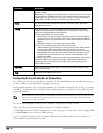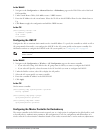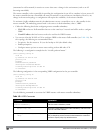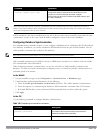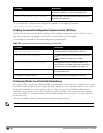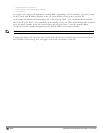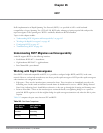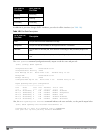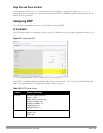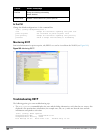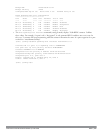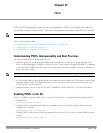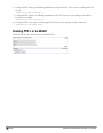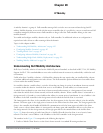
DellPowerConnectW-SeriesArubaOS6.2 | User Guide RSTP | 485
Chapter 26
RSTP
Dell’s implementation of Rapid Spanning Tree Protocol (RSTP) is as specified in 802.1w with backward
compatibility to legacy Spanning Tree (STP) 802.1D. RSTP takes advantage of point-to-point links and provides
rapid convergence of the spanning tree. RSTP is enabled by default on all Dell controllers.
Topics in this chapter include:
l "Understanding RSTP Migration and Interoperability" on page 485
l "Working with Rapid Convergence" on page 485
l "Configuring RSTP" on page 487
l "Troubleshooting RSTP" on page 488
Understanding RSTP Migration and Interoperability
ArubaOS supports RSTP on the following interfaces:
l FastEthernet IEEE 802.3—fastethernet
l Gigabitethernet IEEE 802.3—gigabitethernet
l Port Channel ID—port-channel
Working with Rapid Convergence
Since RSTP is backward compatible with STP, it is possible to configure bridges RSTP (and STP) in the same
network. However, such mixed networks may not always provide rapid convergence. RSTP provides rapid convergence
when interfaces are configured as either:
l Edge ports—These are the interfaces/ports connected to hosts. These interfaces are immediately moved to the
forwarding state. In this mode an interface forwards frames by default until it receives a BPDU (Bridge Protocol
Data Units) indicating that it should behave otherwise; it does not go through the Listening and Learning states.
l Point-to-Point links—These are the interfaces/ports connected directly to neighboring bridges over a point-to-
point link. RSTP negotiates with the neighbor bridge for rapid convergence/transition only when the link is point-
to-point.
Table 145 compares the port states between STP and RSTP.
STP (802.1d)
Port State
RSTP (802.1w)
Port State
Disabled Discarding
Blocking Discarding
Table 145:
Port State Comparison




